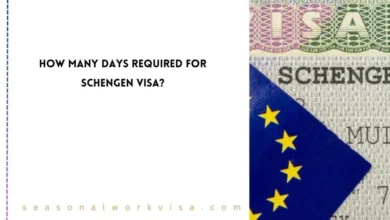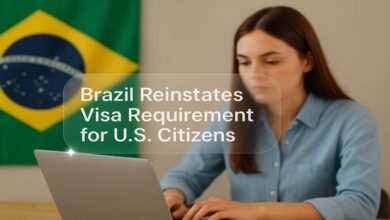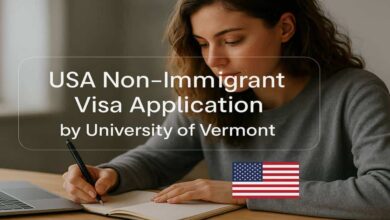How to Get Your I-20 Form for U.S. Student Visa

Studying in the United States is a dream for many students across the world a dream of quality education, international exposure, and rewarding career opportunities. If you’ve received your admission letter from a U.S. college, you’re already halfway there!
The Form I-20 is your official entryway to the F-1 student visa, which allows you to begin your educational journey in the U.S. This form is not just paperwork; it’s the key that opens doors to world-class education, on-campus job opportunities, and even high-paying career paths after graduation, with many international graduates earning $50,000–$80,000 per year or more depending on their field.
Applying for Form I-20 may sound complicated, but don’t worry. This complete guide will walk you through every step from requirements and financial proof to visa interviews and important deadlines so you can confidently begin your U.S. student journey.
What is Form I-20?
An official document produced by a U.S. institution or college recognized by SEVP (Student and Exchange Visitor Program) is the Form I-20, also known as the “Certificate of Eligibility for Nonimmigrant Student Status.” It demonstrates that
It serves as proof that:
- You have been accepted into a U.S. school or university’s full-time academic program.
- You have proven that you have enough money to pay for both your tuition and living expenses while you are in the United States.
- The majority of international academic students are granted an F-1 student visa, which you are qualified to apply for.
When Should You Apply for I-20?
After you accept your admission offer and provide the necessary identification and financial papers, universities typically issue I-20s. Try to finish your I-20 application by April or May 2025 at the latest if you intend to begin your studies in August or September 2025 (fall semester).
Documents Required to Receive the I-20:
These are the usual documentation needed to obtain a Form I-20 from a college or institution in the United States. These are the standard necessities, though precise criteria may differ significantly depending on the institution:
1. Passport Copy:
- a crisp, scanned image of the identity page of the passport.
- The passport must be valid for at least six months after the start of your program.
2. Proof of Financial Support:
Based on the university’s Cost of Attendance (COA), you must show that you can afford tuition, fees, and living expenses for at least a year. Forms of proof that are acceptable include
- Current bank statements (from your sponsor or yourself).
- If your schooling is being paid for by someone else (such as a parent or relative), an affidavit of support is required.
- letter of scholarship or assistantship, if given by the organization.
- letter of loan approval if you’re taking out an education loan.
3. Admission Letter:
- a copy of the official letter of admission attesting to your enrollment in a full-time course of study.
4. I-20 Request Form (University-Specific):
- An internal I-20 request form, often available via the International Student Office or the student portal, is required by many institutions.
- Important information, including your passport details, financial sources, and personal information, is gathered by this form.
What Happens After Receiving Your I-20?
- Amount: $350 USD for F-1 visa applicants
- This obligatory charge connects the U.S. Department of Homeland Security’s database to your SEVIS ID number, which is located on your I-20.
- Where to pay: Online at fmjfee.com
- Save the payment confirmation/receipt, as it will be required for your visa interview.
2. Complete the DS-160 Form (Online Nonimmigrant Visa Application):
- To complete the DS-160 form, go to the official U.S. Department of State website.
- A barcoded DS-160 confirmation paper will be sent to you; print it off and present it to the interview.
- Additionally, you must supply a digital photo that satisfies the requirements for a U.S. visa.
3. Pay the Visa Application Fee:
- Typically, the F-1 visa application price, also known as the MRV charge, is $185 USD; however, this might vary depending on the country of application.
- Check the webpage of your local U.S. embassy or consulate, as payment methods and procedures differ by nation.
4. Schedule Your F-1 Visa Interview:
- To schedule an appointment at the closest American embassy or consulate, use your DS-160 confirmation number.
- If at all possible, make your reservation early and be ready for lengthy wait times.
5. Prepare Required Documents for the Interview:
Bring the following documents to your visa interview:
- Form I-20 (signed by both you and your school official)
- Passport (valid for at least 6 months beyond your intended stay)
- SEVIS Fee Receipt (I-901 confirmation)
- DS-160 Confirmation Page
- Visa Application Fee Receipt (MRV)
- University Admission Letter
- Financial Documents (to prove funding for your education and living expenses)
- Any other documents the embassy/consulate may require
Important Dates for Fall 2025 Students:
1. Latest Date to Apply for I-20:
- falls between May and June 2025, though this varies at every university.
- For precise timeframes, contact the international office of your particular university.
2. Visa Interview Start Date:
- usually starts in May 2025, or as soon as interview slots are available at US embassies and consulates.
- Because of the great demand during the busiest time of year, early scheduling is strongly advised.
3. Program Start Date on I-20:
- Usually listed as mid-to-late August 2025.
- This is the official start date of your academic program.
4. Latest Entry into the U.S.
- According to US immigration laws, you can enter the country up to 30 days before to the commencement of your program.
- This implies that the earliest entrance dates for the majority of Fall 2025 programs would be July 15–August 15, 2025.
What You Can Do with an I-20 Before Starting Your Program?
Following receipt of your Form I-20, the following crucial actions and possibilities are unlocked prior to the start of your program:
- Apply for an F-1 Student Visa:
- This is the I-20’s main objective.
- You will pay the SEVIS fee and schedule your interview for a U.S. visa using the SEVIS ID and school details on the I-20.
- Apply for Education Loans:
- A copy of your I-20 may be requested by many international student loan providers, particularly those in your home country, in order to verify your enrollment and tuition costs.
- When submitting an application for financial aid, it may be used as evidence of enrollment.
- Begin University Pre-Arrival Tasks:
- After obtaining the I-20, the majority of American universities provide orientation materials or to-do lists.
- Housing arrangements, vaccination records, creating student accounts, and course registration are a few examples.
- Book Your Flight to the U.S.
- You can securely make your trip arrangements as soon as your F-1 visa is granted.
- Recall that you have up to 30 days prior to the commencement of your program to enter the United States.
Conclusion:
One of the most important steps in your quest to study in the US is obtaining your Form I-20. It starts the F-1 visa application procedure in addition to verifying your admission and financial preparedness. You can guarantee a smooth journey toward your academic objectives in the United States by planning ahead, assembling the required paperwork, and adhering to the specified procedures. You’ll soon be prepared to start your thrilling journey as an overseas student if you maintain organization and fulfill your deadlines.
Frequently Asked Questions
What is Form I-20?
Form I-20, issued by an SEVP-approved U.S. school, is the Certificate of Eligibility for Nonimmigrant Student Status. It proves your admission to a full-time academic program and sufficient financial support.
When should I apply for the I-20 for Fall 2025 intake?
You should aim to complete your I-20 application by April or May 2025 to stay on track for starting your studies in August or September 2025.




